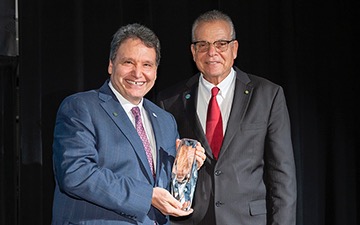UNF professor explains what the recent Chinese tariffs are, how they work and why we should care
September 27, 2018
With the words “trade war” being thrown around lately, one may wonder what is actually going on and how this “trade war” started. Put simply, there has been a recent back-and-forth effort between China and the U.S. to take turns slapping new tariffs onto each other.
Andres Gallo, a professor of Econometrics at the University of North Florida, says that a tariff takes money out of your pocket and gives it to companies who can’t stay competitive with foreign producers.
“They’re a tax on foreign producers that is passed on to consumers,” Gallo said.

So, why would we put a tax on our consumers? First, let’s back up and answer the question of “what is a tariff?”
Simply put, a tariff is a tax on imports. It punishes foreign producers but it also benefits domestic companies by giving them pricing power. This means they can now set their own price and you have to pay for it.
Let’s say the U.S. puts a $1,000 tariff on cars coming into the country. Foreign cars had been selling for the same price as domestic cars but now foreign cars cost $1,000 more because of the tariff. Domestic companies are going to raise their prices to take advantage of the $1,000 buffer that the tariff gives them.
Essentially, the U.S. is punishing China and helping US companies, but it’s coming from the US consumer’s pockets.
Why do we want to punish China?
According to President Trump’s memorandum to the U.S. Trade Representative, “China has implemented laws, policies, and practices and has taken actions related to intellectual property, innovation, and technology that may encourage or require the transfer of American technology and intellectual property to enterprises in China or that may otherwise negatively affect American economic interests.”
Basically, China is forcing U.S. companies to give up their intellectual property, or the ideas behind their products, before they can sell their products in the massive Chinese market. According to Scott Paul from the Alliance for American Manufacturing, this costs U.S. companies $200 to $600 billion per year. Paul says that previous administrations have tried to get China to stop these practices through trade negotiations and disputes through the World Trade Organization. The current administration has decided to use tariffs.
So, will it work?
“The short-term loss of a tariff is that consumers will pay a higher price. The long-term problem is that you are locking your economy into the technology that you have today and there is no incentive to invest in new technologies,” Gallo told Spinnaker. “If you want to help workers, a tariff isn’t the best way to do it. You need to educate these workers and give them the flexibility to move into more productive activities. Otherwise, your workers will be stuck in a low-productivity industry that is subsidized by the consumer, who pays the tariff.”
This is the hard part: certain industries have to shrink, which means laying off workers and producing less product. They can also get more efficient by using more machinery. Otherwise, these companies will die in competition. A tax that makes consumer prices around the country higher is much more expensive than investing in workers and technology.
So, let’s punish China by cutting them off from our markets and let’s protect our producers and the jobs they provide, right? Unfortunately, it’s not that easy.
“By using tariffs, you’re creating an economy where companies will spend more money lobbying for tariffs rather than using that money to innovate. We like entrepreneurs because they take chances but if you have a government that protects existing industries. Why would you take a chance?” Gallo continued. “Once you’ve created this protected industry, you’ve created a protected class and taking away benefits from a protected class who can pool their resources and lobby their representatives is very difficult.”
Well, then how do we fix these trade issues?
“There needs to be an agreement on intellectual property rights, but the U.S. should invest in its workers and focus on technology,” Gallo said. “ Chinese consumers save 50 percent of their income while American consumers only save five percent. Instead of cutting off a producer from our market, we need to expand our own production and develop products that are more attractive to foreign consumers.”
—
For more information or news tips, or if you see an error in this story or have any compliments or concerns, contact [email protected].






















